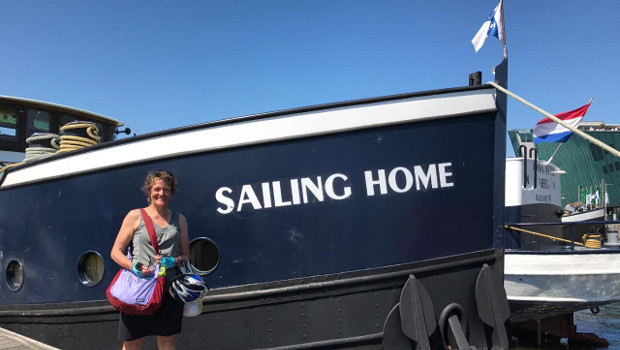Bike helmets and cycling paths: Reflections from an American in Holland

What makes the Netherlands bicycle friendly? Carol Cahill reports after a cycling vacation through the country.
by Carol Cahill, communication & analytics consultant for the Center for Community Health and Evaluation, Kaiser Permanente Washington Health Research Institute (KPWHRI)
I just returned from a dream vacation — a week-long “bike-barge” trip with 24 others from the Seattle area. Each day we cycled 25–30 miles through idyllic Belgian and Dutch landscapes, meeting up with the 150-foot barge Sailing Home in the evening. What struck me immediately is the extensive bicycling infrastructure, particularly in the Netherlands — undoubtedly the best in the world. The countryside is crisscrossed with cycle paths while the cities and towns have bike lanes that are separated from both cars and pedestrians, often paved in a unique color so it’s obvious where you should be.
Around 36 percent of Dutch citizens report using a bicycle as their primary mode of transportation (compared with the European average of 8 percent). In fact, there are more bicycles in the Netherlands than there are people. Most riders sit upright on heavy “sit up and beg”-style bikes, many of which seem beat up beyond rideability, especially in Amsterdam where theft is common and it doesn’t make sense to own an expensive bike. Space for bicycle parking is a perpetual challenge in cities; a walk down most Amsterdam sidewalks means negotiating your way around bikes parked in every conceivable empty space. The cycling culture seems to pay off in terms of health: less than 13 percent of Dutch adults are obese compared to 38 percent in the U.S.
But what about helmets?
The other thing that struck me in the Netherlands was that apart from Americans and racing teams, almost no one wears a helmet. We know from KPWHRI research and other studies that bike helmets can prevent head injuries. So why are the Dutch so resistant to wearing them? I posed this question to a woman I met on a short ferry ride to cross the Waal (i.e., Rhine) River. She replied that for the Dutch, cycling is as much a part of everyday life as sleeping and eating and not seen as potentially dangerous. You wouldn’t wear a helmet to walk or ride in a car, so why would you wear one on a bike? (Presumably the Dutch wear seat belts.)
As the Dutch see it, the main reason Americans insist on wearing helmets is that we don’t have the physical infrastructure to support safe cycling. (Hard to argue with that.) A 2006 survey of Dutch pediatricians — i.e., those most likely to counsel parents about the benefits of helmets — found that nearly all rode a bicycle; when cycling for transportation, 94 percent of those never wore a helmet, because of cultural norms, discomfort, and inconvenience. When stopping in towns with my tour group, I always made sure to keep my helmet in my pannier to prevent theft; it later occurred to me that no one would have wanted to steal it.
And other bike-culture differences?
Something else to keep in mind is that the Dutch also have superior bike-handling skills, developed almost since birth. (I saw a toddler with a pacifier rolling along, propelled Flintstones style by his feet, on a tiny two-wheeled balance bicycle, a typical starter bike.)
In Amsterdam, cyclists stream down every street day and night at a good clip; at intersections, they instinctively know how to flow around each other, even during rush hour. Texting, talking on the phone, and other multitasking is common. Lots of people ride after dark with no front or rear lights. Many parents carry two small children, one riding in front and one behind. It was hard for me to see so many babies with unprotected heads — you never know what small obstacle could bring a bike down.
Attitudes in the Netherlands may be changing, however, with more acceptance of at least having young children wear helmets. This was endorsed by 82 percent of Dutch pediatricians in the 2006 survey. Kids’ helmets have become more comfortable and are designed to look like they’re fun to wear.
I wonder if at least some places in the U.S. can create a culture where family bicycling is a natural, almost instinctive way to get around. My experience in the Netherlands suggests it would be safer for cyclists. During my nearly two-week trip, I didn’t see one bike accident or even a near-miss, save for a six-year-old who fell over when her pedal caught a curb. The only damage was a skinned knee, and she was wearing a helmet.
Immersion in an everyday bicycling culture certainly had an effect on me. Having spent a week in a country where cycling is the norm — no need for special clothing or gear— I resolved to ride my bike at home more for routine trips like the food coop. But I’d gotten used to riding Dutch style and my road bike was so uncomfortable!
After a visit to my local bike shop, I’m now happily riding in comfort on a hybrid step-through bike, able to carry groceries in my new Dutch panniers.